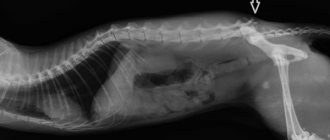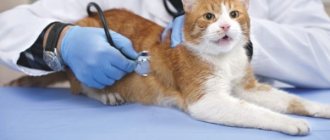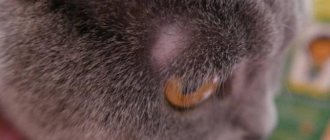Detailed overview of possible causes
It usually doesn’t matter much to a cat which paw the lump appears on, since lameness will be present in both the front and rear limbs. It is more important to find out what caused the compaction and eliminate the possibility of developing serious pathologies. To do this, you need to take your pet to a veterinarian for an external examination and the necessary tests. In most cases, a biopsy of the formation, an X-ray and an ultrasound scan of the damaged limb are performed to exclude the following possible options:
- Insect bites. Cats that roam freely outside are often bitten by ants, wasps, bees, flies and even gadflies. If the bite is in the paw area, a lump the size of a pea may form. In most cases, pets lick the bite site, so finding it will not be difficult. Stinging insect bites can cause slight swelling that goes away on its own within a few hours. Pain is also present, but only when pressing directly on the lesion. It is important to remove the sting if it remains after a wasp or bee sting.
- Injury. If a cat develops a lump on its paw after a fall or active play, then there is a possibility of serious injury related to soft tissues or bones. Cracks or fractures of bones can only be ruled out after an x-ray. The reason for it should be lameness and large swelling of the injured limb. Open fractures require immediate hospitalization of the animal for surgery. For closed fractures or dislocations (after reduction), a fixing bandage is applied until complete healing, which is confirmed by a control x-ray after 10-15 days. In case of bruises, you do not need to consult a doctor if the pet’s general condition is satisfactory and nothing bothers him except for swelling of the limb. Minor bruises disappear within 3-5 days. Hematomas can also resolve on their own, but in some cases it is necessary to puncture them and pump out the contents, especially if they are localized on the bends of the paws. The procedure is painless and takes 10-15 minutes at most. In the future, the owner is told how to care for the wound until complete healing.
- Allergy. In some cases, even food allergies can cause a lump to appear on a cat's paw. But, in most cases, the reason still lies in close contact with a potential allergen (chemicals, wool, house dust or mold). Some cases may be associated with allergies to flea bites or helminthic infestation. A distinctive feature of allergic formations is redness, baldness and severe itching. The latter can cause deep scratches to appear on the animal’s body. If you do not take control of the problem in time, there is a high risk of complicating the process with a bacterial infection. If you can identify and eliminate the allergen from your pet’s daily life or diet, then the skin problems will go away on their own. But, in many cases, it is not possible to immediately identify a potential allergen, so symptomatic treatment is used, including taking antihistamines in combination with hormonal drugs. Unfortunately, some animals suffer from allergies throughout their lives, so lifelong treatment is recommended for them, or it is also called maintenance therapy.
- Neoplasms. May be benign or malignant in origin. A hard lump on a cat's paw may be a cyst or sarcoma. Therefore, if a lump is detected in an animal that is more than 10 years old, it is better not to take risks and immediately carry out a biopsy and histological examination in order to begin treatment on time, if necessary. Depending on the stage and aggressiveness of the cancer, the size of the tumor, chemotherapy or surgical excision of the formation with the capture of healthy tissue may be used. The prognosis depends on the age of the pet and the presence of concomitant pathologies.
This is interesting: Cat allergies - treatment at home
Lump on a cat's paw photo
In older cats, a hard lump on the paw may turn out to be osteosarcoma, which in many cases is inoperable as it is diagnosed in the late stages. Unfortunately, today there are no effective ways to improve or prolong the life of an animal with osteosarcoma if there are metastases.
Signs of lipoma
In the medical literature, neoplasms are called lipomas. What does a wen look like on a cat? It appears as a soft, mobile lump under the skin. It can penetrate between muscles and form on any part of the body. When it contains connective tissue, it becomes more dense. However, areas depleted in adipose tissue are more likely to be affected by the disease :
- upper back;
- breast;
- groin area;
- tail.
Lipoma has a slow growth rate. Usually does not cause discomfort in the cat. But depending on its location, it sometimes causes pain or symptoms of circulatory problems. If a wen forms on a cat’s neck, the pet may die from brain hypoxia or suffocation. When located in the armpit area, lameness is observed. Also, constant friction can provoke the formation of a malignant liposarcoma tumor. If you consult a veterinarian in a timely manner, cats with wen will be cured without complications.
Symptoms of cones in cats
Such neoplasms appear under the skin of a cat. They look like peas or capsules. The cones are mobile and have a fairly soft dough-like structure. They may be painful or not cause any discomfort to the cat.
There may be liquid inside the lump. The appearance of such a neoplasm can cause an increase in local or general body temperature.
It is worth paying attention to whether the cone produces rapid growth.
Should I delete it?
It is clear that a surgeon’s scalpel does not evoke any pleasant associations. However, the final decision on whether to leave everything as is is made only by the veterinarian. Most often, he opts for surgery and here’s why:
- in some cases, the wen malignizes and degenerates into liposarcoma, which clearly leads to death;
- the wen turns out to be not what it seems (that is, the test shows that it is a tumor of a different kind);
- the wen can compress the blood vessels;
- tumors interfere with the cat's movements.
Lipoma in the neck area must be removed
Attention! If the wen is located in the cat's neck area, it must be removed.
Causes of subcutaneous lumps
Small round balls often appear after injection under the skin. They are called post-injection granuloma and resolve on their own a few days after the end of the injections. To avoid them, the injection site is massaged daily. Sometimes granulomas remain for life, without changing their size and position. In other cases, the reason lies in:
- blockage of the sebaceous glands;
- allergic reaction;
- infestation with parasites;
- hormonal imbalances;
- infection of open wounds;
- disturbances in the formation or functioning of connective tissues;
- injuries;
- inflammatory processes.
The risk group includes older animals, cats with chronic diseases, late castrated and sterilized pets. The risk of developing cancer increases with constant stress, low activity and poor diet. A predisposition also appears with frequent injuries in the same area of the body, infection with leukemia and regular inhalation of tobacco smoke. Cancer is often inherited and is diagnosed in animals older than 7 years.
This is interesting: Why does the kitten have a red butt?
Reasons why the paw has a bump
Pathological bumps on a cat’s paw can appear regardless of the cat’s age—one year old or 15 years old. They are not necessarily malignant in nature, and therefore you should not immediately panic when you discover a tumor on your pet’s paw.
Most often, a lump appears when the following reasons are present:
- Trauma - if a cat hits its paw, a painful lump forms at the site of the bruise, which can be of considerable size. After the tissues recover from the injury, the lump will disappear without consequences. In this case, nothing more needs to be done. Sometimes the seal can last up to 1 year if the bruise was very severe. It is not uncommon for a cat to develop bumps on its hind legs due to its limbs being pinched by a door. In such a situation, the posterior spine may also be injured. A lump appears, and when the dog bites;
- Consequences of a tick bite - if a cat has suffered from a tick, and when the parasite is removed, its head remains in the tissues of the paw, then it can come out with pus, and then a lump will not form. It also happens that the tissues over the bite site are tightened, and the head of the tick ends up under the skin. The paw slowly becomes inflamed. Because of this, a lump appears on the paw under the skin. In such a situation, internal suppuration gradually develops, due to which a small bump appears on the paw, which is not painful. Gradually it increases in size and turns a little red, after which it breaks out and the head of the tick, along with a curd-like pus, leaves the body. This phenomenon is observed not only on the paws, but also on the skin of the neck and the whole body;
- Benign neoplasms - in cats that roam freely on the street, they appear quite often due to minor injuries that cause muscle separation or disturbances in the deposition of fatty tissue. Once such a tumor is removed, it almost never reappears. Surgical treatment is carried out only if the tumor interferes with the pet. It is imperative to visit a veterinarian if a lump appears on your paw. If the paw is functioning normally, the tumor is not removed;
- A malignant tumor - a lump in this case grows quite quickly. Both the front and back paws may be affected. It can reach a significant size in a short time, and at the same time the fur on it is actively falling out. The lump becomes bare. These tumors often ooze clear or bloody fluid. Possible leakage of pus. If there is no metastasis and the cat’s condition is satisfactory, it is possible to remove the tumor; as a rule, the entire paw is involved.
After surgery, the risk of new malignant tumors appearing in the body cannot be excluded. A veterinarian must constantly monitor the animal’s condition. Having discovered a cancerous tumor in an animal again, the specialist raises the question of a repeat operation.
If a cat has a lump on its paw, it is important to immediately seek veterinary help. A lump on a joint in a cat most often indicates inflammation, which is accompanied by abundant formation of estrudate. The paw hardly moves at all.
If a lump is found on a cat's paw, there is no point in panicking, and you need to examine the animal. The process can be either acute or chronic, but it does not pose a immediate danger to life. However, you cannot put off visiting a specialist for too long.
Diagnosis and treatment of neoplasms
Diagnosis is carried out when any neoplasm appears. After a thorough examination, the doctor determines the level of danger of the resulting compaction and selects the appropriate therapy.
In addition to a clinical examination and history taking, it is necessary to check the functionality of the heart, study a general analysis of urine and blood, and also do a bacteriological analysis of the contents of the lump-vesicle. Using ultrasound and x-rays, the doctor determines the depth, exact location and size of the tumor. At an early stage, cancer is often asymptomatic, so biopsy and endoscopy are used to detect it.
The location of oncology development directly depends on the sex of the animal. Cancer in cats most often affects the testes, and in cats - milk bags. If the disease is detected at an early stage, therapy is reduced to taking special medications and gives positive results. At later stages the prognosis is negative. The patient is given painkillers and euthanized.
Table of primary and additional therapy
Drug or surgical therapy depends on the diagnosis, the state of immunity and the stage of development of the disease. Recommended treatment methods can be found in the example table.
| Type of pathology | Therapy | |
| Main | Additional | |
| Lipoma | Surgical excision of large lumps | Lipomas located near the spinal column or neck are not recommended to be touched. Intervention is allowed only if the lipoma is growing steadily |
| Hemangioma | Non-interference and surveillance | Complete surgical removal on an individual basis |
| Adenoma | Subcutaneous and intramuscular injections of antibiotics, antiviral and antifungal drugs | Surgery for increasing size |
| Mastitis | The animal is given a novocaine blockade, physiotherapy, a course of antibiotics and compresses are prescribed. | In advanced forms, surgical intervention is used |
| Cancer | In addition to special medications, the doctor prescribes radiation or chemotherapy followed by removal of the tumor | In later stages, pain management is used and euthanasia is recommended. |
| Abscess | An autopsy is performed and pus is removed using antiseptics. The treated area is isolated with a sterile bandage. Any remaining infection is treated with a course of antibiotics. | Long-term use of antibiotics is dangerous for the developing organism of kittens. If the animal is less than 1 year old, the veterinarian tries to reduce the recommended duration of antibiotic therapy as much as possible. |
| Cyst | For small formations, observation is recommended; for large ones, removal | Sometimes parasites are found in the growths. In this case, surgery is necessary even for a small cyst |
| Hernia | To remove a hernial lump, massage sessions are prescribed, the prolapsed organ is put back in place | For large formations, the doctor performs surgery to stitch the diverging ring |
| Inflammation of the paraanal glands | The accumulated fluid is squeezed out, facilitating the production of secretions | If pain occurs, the animal is injected with novocaine. If a predisposition to inflammation is identified, the cat will have to be taken for the procedure several times a year. |
| Eosinophilic granuloma | Based on the cause of the pathology, the cat is prescribed antibiotics, antihistamines or steroids. | A large weeping wound is usually excised to preserve the appearance of the affected area |
| Lymphadenitis | The disease is not independent and occurs against the background of another pathology. Painkillers, anti-inflammatory and antibacterial drugs are used for treatment | A large number of inflamed lymph nodes indicates leukemia. This pathology is not fatal, but requires long-term drug treatment |
Syringoepithelioma is not considered dangerous to health, so treatment is not provided. Hematomas resulting from minor injuries usually go away on their own or are eliminated with healing ointments.
In addition to traditional scalpel work, surgeons use laser excision, electric shock, or freezing at low temperatures with liquid nitrogen. Young and healthy animals with strong immunity often heal on their own. In this case, they receive immunity, eliminating subsequent relapses.
After surgery, the animal is prescribed a course of immunomodulators that stimulate the functioning of immune cells. The remaining wound is treated with healing ointments. Bandages can be changed yourself or at a veterinary clinic. Be sure to consult a doctor if pus continues to leak from the bandage after surgery. Some tumors found in cats are dangerous not only for animals, but also for humans.
What to do with purulent and bleeding seals?
The appearance of bleeding and purulent discharge is a symptom of cancer. Immediately upon discovering a problem, take your pet to see a veterinarian.
Before visiting a doctor, it is prohibited to treat wounds with alcohol-containing solutions, squeeze out or puncture the lump. It is also not allowed to use any ointments without prior consultation. Even plain water can make the situation worse, so do not try to rinse or wet the swelling.
If the seal breaks on its own, provide first aid to the animal. To do this, you need to treat the wound with an alcohol-free antiseptic and apply a sterile bandage. All these actions do not exclude a veterinary examination.
Causes
Doctors hypothesize that lipoma develops as a result of metabolic changes that arise due to a deficiency of protein regulatory enzymes. The appearance of wen in a cat is due to the blocking of the ability to break down fat due to a lack of the enzyme lipase. Cats are significantly less likely to develop this disease than dogs.
The most common causes of wen development:
- elderly animals;
- autosomal dominant heredity;
- metabolic disease;
- hormonal disbalance;
- diseases of an endocrinological nature;
- feminine animals.
Prevention recommendations
Prevention alone cannot prevent cancer, but proper adherence to basic recommendations will reduce the likelihood of its occurrence. For the health of your beloved pet it is important:
- Check regularly with a veterinarian. After 7 years, the number of preventive examinations increases to twice a year. This helps to diagnose the disease at an early stage and prescribe treatment in a timely manner.
- Refuse to purchase hormonal contraceptives. Artificial suppression of sexual desire negatively affects the hormonal background of the animal. Because of this, the body malfunctions and stimulates the development of cancer cells.
- Resort to sterilization. Surgery to remove the uterus and ovaries is performed after puberty and minimizes the risk of developing cancer. General anesthesia is more difficult to tolerate at a later age.
- Treat against parasites in a timely manner and follow the vaccination schedule. When affected by helminths, ticks or viruses, secondary infections often occur.
- Monitor the quality of the diet. Any drop in immunity is fraught with deterioration in well-being.
- Follow the rules of care. Keep your skin, ears and eyes clean. Do not let your cat become hypothermic. Owners of hairless breeds are advised to purchase warm clothing for their pets.
- Avoid excessive sun exposure. Frequent exposure to direct sunlight is one of the causes of the appearance of malignant tumors.
- Monitor for swelling. Regularly push back your cat's fur and check for any questionable lumps.
- Contact your veterinarian if in any doubt. It’s better to be wrong in your assumptions than to miss the moment and lose your furry pet.
Treating cancer is hard work. Due to the constant progression of the disease, it is very important to diagnose it early. If you notice a small lump on your pet’s body that is not accompanied by dangerous symptoms, then do not lose your vigilance - veterinarians recommend undergoing an examination even if all symptoms indicate a benign neoplasm.
The article is for informational purposes only. Contact your veterinarian!
Hormonal disorders and breast cancer
The second reason for the formation of lumps in a dog may be the development of a mammary tumor. Unlike mastopathy, tumors usually have focal localization. There are several causes of breast tumors. But the main predictive factors are the following: - constantly recurring estrus - long-term absence of mating during the reproductive period - hereditary factor - long-term use of hormonal drugs
Tumors on the mammary glands can be either benign or malignant. But the percentage of benign formations is very small. Thus, 9 out of 10 neoplasms on the mammary glands in cats are cancer. Tumors can be easily detected by simply palpating the surface of the mammary glands. You may notice the appearance of lumps and nodules in your dog, which may increase in size if no measures are taken. As a result, the tumor can grow and develop into a malignant pathological form.
At first, the tumor is usually quite small in size and rarely grows, but the tumor can abruptly move into the first stage of the disease after false pregnancy. The number and size of the bumps may increase, and the surface becomes bumpy.
If you trust statistics, then a common cause of death for most animals in the second half of life is oncology in cats and dogs . It firmly holds second place among the causes of overall mortality. However, as in humans, if a tumor and lump in a cat are detected in a timely manner, then surgical treatment in the early stages usually leads to a complete recovery. If you do not seek help from a veterinarian in time, the tumor will grow and cause complications. Enlarged lymph nodes may be noted. At the last stage, the tumor metastasizes to other organs. At this stage of the disease, the prognosis is unfavorable with any type of treatment. Frequently asked veterinarian questions
If a cat has a small and single lump near the nipple, should it be taken to the vet? Naturally. Even the smallest neoplasm can become the beginning of a malignant tumor. It is easiest to take action at the onset of the disease.
If the mammary gland is swollen over the entire surface, but the cat feels well and eats, then should you worry? Swelling may be a sign of an unfavorable process. To find out exactly the nature of the process, you need to contact a veterinary clinic.
The cat has lumps all over the mammary gland. The doctor suggested removing the entire gland. Is this dangerous for the dog? There are no simple operations. Especially oncological ones. The intervention proposed to you should be carried out by a veterinarian with experience in such interventions. After surgery, a histological examination is required. And, if necessary, adjuvant chemotherapy.
Incipient breast tumor.
Developed breast tumor.
As soon as a lump has been detected in a cat or dog, or if there are indirect signs that allow one to suspect cancer, we recommend that you consult a veterinarian without the slightest delay.
Unfortunately, this problem cannot be solved at home. We have all the necessary conditions for the examination and treatment of cancer in dogs and cats.
Breast tumor. Despite its small size, this is already a neglected case. Metastases.
Establishing diagnosis
Due to the fact that lipomas do not cause pain, owners often do not pay attention to them. However, after detecting a formation in a cat, it is important to consult a doctor to determine the correct diagnosis. This is explained by the fact that only in the clinic will they be able to determine whether it is a wen or other types of malignant tumor. And also prevent the growth of the tumor. Wen is not an infectious disease and therefore cannot be transmitted to people or other pets.
The veterinarian carries out a number of preliminary measures:
- signs of a wen in a cat are determined by external examination;
- X-ray, ultrasound; puncture biopsy.
When palpating a cat, single wen can be easily felt. They are soft and easy to move. An x-ray will determine the presence of metastases. In cases where wen is located in hard-to-reach areas, ultrasound will help determine the need for surgery. Using a biopsy, the type of cells that make up an organ or formation in it is determined. A puncture biopsy will clarify the nature of the tumor: benign or malignant. Cytological examination is carried out before surgery.
Complications
Sometimes such a formation can lead to an abscess in a pet.
If a tumor in the form of an abscess located under the skin bursts, there is a high probability that the pathological exudate will spread into deeper layers, which will ultimately lead to a severe abscess, often ending in the death of the animal. Therefore, if the skin is swollen and there is pus inside the tumor, you should not squeeze it out yourself. It is better to contact a veterinarian who will help get rid of the problem.
Things are much more complicated with malignant neoplasms. The fact is that degenerated cells grow rapidly, affecting surrounding tissues and lymph nodes. Soon they are separated from the main tumor and spread throughout the body through the bloodstream, affecting organs and systems. If a cat's cancer is diagnosed at a late stage, the chances of recovery are very low. To prevent the animal from suffering, the veterinarian will advise euthanizing it. Therefore, in order to avoid such sad consequences, it is necessary to immediately take the cat to the doctor if an incomprehensible neoplasm has formed under its skin on any part of the body.
Types of bumps on cats' paws and their causes
Despite the fact that the types of bumps on cats’ paws and their causes vary greatly, even a not very “veterinarian” owner, after taking a good look, will be able to at least roughly guess the nature of the neoplasm and how urgently it is necessary to seek veterinary help.
Main pathogenic factors:
- Cones of purulent origin. If a splinter (grass stubble, for example) gets under the skin on the paw, then the pathogenic and conditionally pathogenic microflora located on its surface gradually causes inflammation. However, an abscess that appears as a result of bites is much more typical. Because there is no access to oxygen; over time, a lump filled with purulent exudate forms in this place.
- Pyoderma, which occurs as a result of severe deterioration of immunity and contamination of the skin with streptococci or staphylococci. However, neoplasms with pyoderma rarely develop to the point of large lumps. As a rule, such “pimples” are no larger in size than a large cherry. In addition, they are numerous, and therefore it is extremely difficult to mistake them for a single cone.
- Strong blows ending in the formation of a hematoma. In these cases, small (and other) blood vessels “explode” under the skin, as a result of which the newly formed cavity is gradually filled with blood. A separate and rare variety is “lymphotomes”, i.e. similar neoplasms that appear as a result of damage to the lymphatic vessels. If the skin is damaged, the hematoma may be complicated by the development of purulent inflammation.
- Edema. Such bumps also appear suddenly, and they are not easy to detect visually. Much more often their appearance is diagnosed by palpation of the cat's paw.
- Benign neoplasms (tumors). They are generally quite soft and slow growing. Most often, they appear in old cats, and their occurrence cannot be called rapid: such tumors can grow for years.
- Cases of the formation of large warts and papillomas can be considered a type of benign formations. They bear little resemblance to “typical” cones, since in this case there is a clearly defined neck and body of the neoplasm, which is why the latter often dangles on the cat’s paw, resembling a small, leathery “pendulum.”
- Malignant neoplasms (cancer). In this case, the tumors are tougher, grow many times faster, and sometimes their appearance takes several weeks. This reason for the formation of cones is extremely dangerous, because... Through metastasis, tumors can quickly spread throughout the body.
- Poisonous insect bites, poisonous herb burns. Of course, such cones are found either only in the summer, or exclusively in the southern regions. They arise spontaneously, very quickly. Often accompanied by the development of allergic reactions. If the dose of poison was large, or if the cat is susceptible to the poison that entered its body, the pet may well die.
- If the lump appears somewhere in the area of the fingers, you can suspect that the animal has a fungal or yeast infection (malasseziosis, for example). In cats, such diseases are somewhat less common than when compared with dogs, but such cases do exist. A characteristic sign of these ailments is a sharp, specific smell. Sometimes it resembles the aroma of cheese or mold, but sometimes the paws of a sick cat can noticeably “smell” like old socks.
- Lumps of a cystic nature. Typically, cysts (fluid-filled blisters) appear in internal organs, but there are also more rare cases of their formation on the paws or other surfaces of the body. They grow rather slowly, but their appearance causes a lot of trouble for the animal: they hurt a lot, itch, which is why the cat constantly scratches them or even chews them until they bleed. This process is often supplemented by the participation of pathogenic pyogenic or necrotic microflora.
- Lump in the joint area. In most cases, this happens either after severe injuries (falls, bruises, a cat falling under the wheels of a vehicle), or against the background of old, advanced cases of arthritis and arthrosis. In this case, the cat’s joint capsule is destroyed, and the synovial fluid immediately or gradually flows under the skin. The process is similar to the principle of hematoma formation.
- The lump may be a consequence of edema, including an allergic nature. Considering that even relatively harmless urticaria can cause anaphylactic shock, it is better to immediately show the cat to a veterinarian.
- Finally, the lump can develop from the inside, i.e. be the result of growths on the bone itself. This can be a consequence of poorly healed fractures, or, what is much worse, it can be a sign of sarcomas, osteoblasts and other oncological pathologies of bone tissue.
Signs
Under the skin, between the skin and the muscle layer, nodules or capsules with liquid contents may form in your pet. They are “dough-like”, mobile and do not cause trouble for your pet. The lumps may be hard and painful.
Subcutaneous formations consist of degenerated tissues, or are capsules filled with contents (dense or serous). They have normal body temperature or are dense and hot to the touch. At the same time, the animal’s general body temperature may increase, and other signs of general intoxication may appear (weakness, refusal to eat, irritability or lethargy, dyspepsia). Formations prone to rapid growth deserve special attention.
Types of wen
Lipomas can occur in both the singular and plural. The second type often occurs with diseases of the endocrine system. The medical name is lipomatosis.
According to the nature of germination, there are two types of lipomas:
- Infiltrative. Surgical intervention is quite difficult due to penetration into surrounding tissues: muscles and vascular bundles. There are no clear boundaries. Consist of bundle-shaped accumulations of fat fibers. They quickly grow to enormous sizes. They develop into malignant formations in cats;
- Non-infiltrative (simple). The small size of the wen is clearly localized in a specific area, due to its limitation by the tissues surrounding it. Does not affect nearby muscles. Removal is easy.
Diagnosis by the appearance of the lump
As we have already written, diagnosis by the appearance of the lump is quite possible. But for successful diagnosis, it is necessary to pay very close attention to both the appearance of the neoplasm and its consistency.
The smell also plays a big role, even if it is often far from the most pleasant.
soft bump
If the lump is soft, its causes may be:
- Purulent inflammation.
- Hematoma in the initial stage, release of synovial fluid, pyoderma.
- Soft bumps are benign tumors. This is especially true for large warts and papillomas.
Solid
If the lump is hard, the reasons for its formation may be:
- Bone growth.
- Cancer or “mature” benign tumor.
- Old hematoma.
- Edema.
Black
If the lump is black, it may indicate:
- In cats with thin skin, an old and fully mature hematoma may look like this.
- Many types of malignant neoplasms are black in color. However, warts with papillomas can also be painted black.
- It could be some kind of “cunning” fungus.
Red
If the color of the cone is red, its causes may be:
- In animals with thin and delicate skin, young hematomas look like this.
- This coloration is characteristic of many malignant and some benign tumors.
- Redness is characteristic of all types of inflammatory reactions, including the initial stages of abscesses.
- Such a lump may be the result of a burn, insect bite, etc.
Purulent
Oddly enough, a purulent lump is not in all cases an abscess (but it often is).
Discharge of pus may indicate:
- Hematoma, bruise, wound and other types of inflammatory foci “infected” with pyogenic microflora.
- For a malignant tumor in the stage of decay and decomposition. The animal experiences severe pain, and this condition is also fraught with metastasis.
Cone without hair
In the case where the neoplasm is without hair, this in almost 100% of cases indicates its “venerable” age. The reasons for the formation of a lump can be very different:
- Benign and malignant tumors (oncological lumps go bald early and in clumps).
- Old hematoma.
- Old consequences of arthritis, arthrosis, large bone callus, etc.
If the lump bleeds
When a lump bleeds, the reasons for its formation can be quite serious:
- Malignant tumors often behave this way.
- This often happens with tumors resulting from severe bruises and other injuries.
- Sometimes such signs indicate bites from poisonous insects and even snakes. In this case, the lump does not just bleed, a small amount of ichor mixed with blood clots is released from it.
Lump on a joint
If a lump forms on the joint, this may be a consequence of:
- Arthritis, arthrosis.
- This happens when the joint capsule is destroyed.
- It could be a tumor.
Types of bumps under the skin of a cat
Cones can have a different nature, depending on the animal’s predisposition to a particular disease.
Lipoma (wen)
At first, a small formation appears, which gradually grows and can grow to the size of a chicken egg. The cause of lipoma is improper distribution of fat after clogged pores. Lipoma is a benign neoplasm that does not metastasize and does not cause discomfort. The exception is if the lipoma occurs on the back or neck. The lipoma does not hurt even when pressed, it does not affect life processes: the appetite is preserved, the animal’s normal behavior, the temperature is normal.
In older animals, the appearance of lipomas may indicate the onset of cancer. You should definitely have your cat examined by a veterinarian.
Abscess
An abscess appears at the site of a bruise, any internal injuries, or in case of an incorrect injection.
The tumor appears approximately on the 3rd day after injury, gradually growing.
Unlike a lipoma, an abscess is a painful condition, accompanied by an increase in temperature and depression of the pet’s condition.
The abscess is firm to the touch, but not hard. You can feel accumulated pus inside. If the abscess is not completely healed, pus is released into the hole when pressed.
Lymphadenitis
Inflammation of the lymph nodes. The lump is extremely painful even with slight pressure. The animal's condition is depressed, the temperature is elevated, and the appetite is reduced.
Cyst
A cyst is a benign tumor. A cyst is a lump filled with fluid from the inside. This tumor grows slowly and does not affect the cat’s condition; the cyst is not painful.
Tumor as a reaction to vaccination
Usually there is a slight swelling, a little painful, accompanied by redness.
Oncology
The most terrible type of neoplasm. This is what the owner thinks about when he feels a lump on his pet’s body. Cancer spreads very quickly and metastasizes throughout the body. Inevitably leads to the death of the animal, but in the first stages of the disease it often does not manifest itself.
Lipoma treatment
It is not recommended to self-medicate a cat’s wen, and especially to use folk remedies. Compresses and lotions can cause irritation and lead to infection. Opening the lump with a needle and squeezing it out will lead to the growth and degeneration of the formation into a malignant tumor.
After the diagnostic methods have been carried out, the veterinarian makes a final diagnosis and then prescribes one of two types of treatment:
- control of changes in the size of the wen;
- surgical intervention.
If a decision is made not to remove the lipoma, the cat owner must constantly monitor the dynamics of all changes occurring with the formation. There is a minimal chance of it disappearing without surgery. This is facilitated by a decrease in blood flow with further death of the wen. However, dead tissue must still be removed.
Causes and symptoms of lumps
A cat's lump under the skin can be malignant or benign. In the first case, the pet should be prescribed treatment as soon as possible, but it may not bring a positive result.
But the lump can also be a benign neoplasm. In this case, there is no need to panic, but it is better to show the cat to the veterinarian as soon as possible so that he can do the necessary research.
If a cat has a lump, this does not mean that the pet is experiencing pain or stress - often the lumps are painless.
Lumps can be very painful - most often this indicates some kind of disease. Even if the lump is not painful and benign, even this can significantly worsen the animal’s life. It is especially dangerous if the lump occurs on the back: this can lead to blockage of blood vessels, blood and oxygen do not reach the organs, and this condition can result in paralysis of the limbs or death.
When not to interfere
The veterinarian does not always recommend going under the knife. If the wen does not interfere with your life, you can leave it alone. Thus, the question of surgery is postponed if the neoplasm:
- does not cause pain or serious discomfort;
- small in size and does not grow;
- has no signs of inflammation or pus.
Under no circumstances should you pierce a lipoma, warm it up, or apply lotions. It will not resolve on its own. This can only provoke its growth, and therefore its degeneration into a malignant one.
Lipoma can only be removed by a veterinarian
Should we remove a wen on the neck?
Cervical wen is always cut out, even if it seems that the neoplasm does not bother the cat in any way. In this case, there is always a risk that the tumor will compress important blood vessels and disrupt the flow of oxygen to the brain. The latter is fraught with brain hypoxia and death.
First aid and treatment for cats
You cannot begin treatment without making an accurate diagnosis. The pathogenesis of diseases is so different that carrying out any therapeutic measures may not have a therapeutic effect, but lead to irreversible consequences.
For different diseases and in different phases, completely different procedures are indicated, for example, warm compresses and cooling ones, or tight bandages and gentle ones.
If it is not possible to quickly see a doctor, then you can help the animal according to the main principle of doctors - do no harm:
- provide the four-legged with peace;
- if there is a violation of integrity, lubricate the area with syntomycin emulsion, tetracycline ointment or any other antibiotic-based ointment;
It is forbidden:
- apply bandages (tight, soft, etc.);
- cover infected wounds with dry powders such as streptocide;
- apply massage, rubbing and irritating ointments;
- apply cold and heat;
- postpone visiting the doctor.
Prevention and hygiene of paws
Quite often you can see a cat washing itself. She licks her paws thoroughly. Cat saliva contains the enzyme lysozyme, which has a pronounced antiseptic property. It is this substance that ensures the hygiene of the paws and all places that the animal licks.
If an animal visits the street, it is a good idea to wash its paws with lukewarm water and wipe with a napkin. If the walk happened in the rain, then you should wash the dirt more thoroughly.
Some owners limit themselves to wiping their paws with special wet, scented wipes. This cannot be done. Such napkins are impregnated not only with “perfume” but also with other substances, and the animal, by licking its paws, can swallow the remains.
The basis of lump prevention is inspection and palpation. When playing or stroking an animal, you can always notice on or under the skin:
- seals;
- wounds;
- areas of skin without fur;
- cones;
- growths.
Any foreign body that is not familiar to the animal should alert you. While observing an animal, it is easy to spot a place of increased interest. It is necessary to immediately examine it to identify the cause.
A timely visit to a specialist will help identify the pathological process at the initial stages, establish a diagnosis and provide timely, qualified assistance.
Rehabilitation period
After picking up your cat from the clinic, it is important to follow all the recommendations prescribed by the veterinarian. The doctor will explain what needs to be done and how to properly treat the wound after removing the wen.
The rehabilitation period requires strict adherence to the following points:
- droppers to prevent dehydration;
- sedatives and painkillers;
- antibiotics and anti-inflammatory drugs;
- bandage the wound until complete recovery;
- protective collar around the neck;
- seam care;
- constant monitoring of the general condition of the cat.
The animal needs daily dressings. The incision should be kept clean. It is necessary to exclude the possibility of licking the wound. Until the suture is completely healed, the wound should be covered with a bandage. If your cat has a wen on her stomach, use a bandage after surgery. The bandage should be well fixed. This will prevent infection, which could slow down your cat's recovery. If inflammation or bleeding occurs, you should contact your veterinarian for advice.











